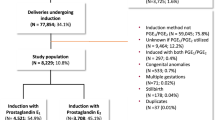Abstract
Objective:
Compare mechanical and pharmacological ripening for patients with oligohydramnios at term.
Study design:
Fifty-two patients with oligohydramnios ⩽5 cm and Bishop score ⩽6 were randomized for labor induction with a vaginal insert containing 10 mg timed-release dinoprostone (PGE2) or double-balloon catheter. The primary outcome was time from induction to active labor. Time to labor, neonatal outcomes and maternal satisfaction were also compared.
Result:
Baseline characteristics were similar. Time from induction to active labor (13 with PGE2 vs 19.5 h with double-balloon catheter; P=0.243) was comparable, with no differences in cesarean rates (15.4 vs 7.7%; P=0.668) or neonatal outcomes. The PGE2 group had higher incidence of early device removal (76.9 vs 26.9%; P=0.0001), mostly because of active labor or non-reassuring fetal heart rate. Fewer PGE2 patients required oxytocin augmentation for labor induction (53.8 vs 84.6% P=0.034). Time to delivery was significantly shorter with PGE2 (16 vs 20.5 h; P=0. 045)
Conclusion:
Intravaginal PGE2 and double-balloon catheter are comparable methods for cervical ripening in term pregnancies with oligohydramnios.
This is a preview of subscription content, access via your institution
Access options
Subscribe to this journal
Receive 12 print issues and online access
$259.00 per year
only $21.58 per issue
Buy this article
- Purchase on Springer Link
- Instant access to full article PDF
Prices may be subject to local taxes which are calculated during checkout
Similar content being viewed by others
References
Gramellini D, Fieni S, Verrotti C, Piantelli G, Cavalloti D, Vadora E . Ultrasound evaluation of amniotic fluid volume: methods and clinical accuracy. Acta Bio Med Ateneo Parmanesse 2004; 75 (Suppl 1): 40–44.
Casey BM, McIntire DD, Bloom SL, Lucas MJ, Santos R, Twickler DM et al. Pregnancy outcomes after antepartum diagnosis of oligohydramnios at or beyond 34 weeks' gestation. Am J Obstet Gynecol 2000; 182: 909–912.
Moore TR, Cayle JE . The amniotic fluid index in normal human pregnancy. Am J Obstet Gynecol 1990; 162: 1168–1175.
Chauhan SP, Sanderson M, Hendrix NW, Magann EF, Devoe LD . Perinatal outcome and amniotic fluid index in the antepartum and intrapartum periods: A meta analysis. Am J Obstet Gynecol 1999; 181: 1473–1478.
Voxman EG, Tran S, Wing DA . Low amniotic fluid index a predictor of adverse perinatal outcome. J Perinatol 2002; 22: 282–285.
Venturini P, Contu G, Mazza V, Facchinetti F . Induction of labor in women with oligohydramnios. Matern Fetal Neonatal Med 2005; 17: 129–132.
American College of Obstetriclans and Gynecologists. Induction of Labor. ACOG Practice Bulletin Number 10. Washington DC: American College of Obstetricians and Gynecologists; 1999.
Tuuli MG, Keegan MB, Odibo AO, Roehl K, Macones GA, Cahill AG . Progress of labor in women induced with misoprostol versus the foley catheter. Am J Obstet Gynecol 2013; 209: 237. e1–7.
Abramovici D, Goldwasser S, Mabie BC, Mercer BM, Goldwasser R, Sibai BM . A randomized comparison of oral misoprostol versus Foley catheter and oxytocin for induction of labor at term. Am J Obstet Gynecol 1999; 181: 1108–1112.
Culver J, Strauss RA, Brody S, Dorman K, Timlin S, McMahon MJ . A randomized trial comparing vaginal misoprostol versus Foley catheter with concurrent oxytocin for labor induction in nulliparous women. Am J Perinatol 2004; 21: 139–146.
Oraes Filho OB, Albuquerque RM, Cecatti JG . A randomized controlled trial comparing vaginal misoprostol versus Foley catheter plus oxytocin for labor induction. Acta Obstet Gynecol Scan 2010; 89: 1045–1052.
Jozwiak M, Bloemenkamp KW, Kelly AJ, Mol BW, Irion O, Boulvain M . Mechanical methods for induction of labour. Cochrane Database Syst Rev 2012; 3: CD001233.
Chung JH, Huang WH, Rumney PJ, Garite TJ, Nageotte MP . A prospective randomized controlled trial that compared misoprostol, Foley catheter, and combination misoprostol-Foley catheter for labor induction. Am J Obstet Gynecol 2003; 189: 1031–1035.
Wang W, Zheng J, Fu J, Zhang X, Ma Q, Yu S et al. Which is the safer method of labor induction for oligohydramnios women? Transcervical double balloon catheter or dinoprostone vaginal insert. J Matern Fetal Neonatal Med (e-pub ahead of print 3 February 2014 doi:10.3109/14767058.2014.880880).
Sciscione AC, Nguyen L, Manley J, Pollock M, Maas B, Colmorgen G . A randomized comparison of transcervical Foley catheter to intravaginal misoprostol for preinduction cervical ripening. Obstet Gynecol 2001; 97: 603–607.
Larson JD, Rayburn WF, Turnbull GL, Schwartz WJ, Stanley JR, Christensen HD . Effects of intracervical prostaglandin E2 on fetal heart rate and uterine activity patterns in the presence of oligohydramnios. Am J Obstet Gynecol 1995; 173: 1166–1170.
Dede FS, Haberal A, Dede H, Sivaslioglu A, Arslanpence I . Misoprostol for cervical ripening and labor induction in pregnancies with oligohydramnios. Gynecol Obstet Invest 2004; 57: 139–143.
Acknowledgements
This study was not supported by external funding. Faye Schreiber is thanked for help in preparing this manuscript.
Author information
Authors and Affiliations
Corresponding author
Ethics declarations
Competing interests
The authors declare no conflict of interest.
Rights and permissions
About this article
Cite this article
Shechter-Maor, G., Haran, G., Sadeh-Mestechkin, D. et al. Intra-vaginal prostaglandin E2 versus double-balloon catheter for labor induction in term oligohydramnios. J Perinatol 35, 95–98 (2015). https://doi.org/10.1038/jp.2014.173
Received:
Revised:
Accepted:
Published:
Issue Date:
DOI: https://doi.org/10.1038/jp.2014.173
This article is cited by
-
Safety and efficacy of double-balloon catheter for cervical ripening: a Bayesian network meta-analysis of randomized controlled trials
BMC Pregnancy and Childbirth (2022)
-
Induction of labor methods in isolated term oligohydramnios
Archives of Gynecology and Obstetrics (2019)
-
Double-balloon catheter versus dinoprostone insert for labour induction: a meta-analysis
Archives of Gynecology and Obstetrics (2019)


